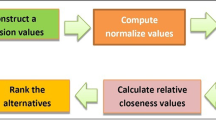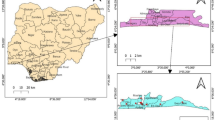Abstract
In this paper, a new hybrid method is developed that incorporates the rationale of truncated power basis (TPB) and artificial bee colony-back propagation neural networks (ABC-BPNN) into an adaptive fuzzy semi-parametric regression model yielding more accurate results and better generalization ability. The proposed adaptive fuzzy semi-parametric regression model comprises sub-model formulation and approximates the observed fuzzy outputs from the outside employing neural networks computation, such that the proposed adaptive fuzzy regression model better explains the inherent dependence and vagueness that exist in a given dataset. Using the cross-validation criterion and absolute deviation-based distance measures for LR-type fuzzy numbers, a target function optimization problem of constructing the adaptive fuzzy semi-parametric regression is performed by solving the smooth function, bandwidth of kernel function, and regression coefficients. This strategy significantly increases the goodness of fit for the proposed algorithm and offers a dependence framework among magnitude and uncertainty for the fuzzy regression model. We also use three formula measures to evaluate the fit quality of the regression results within each membership function as well as in the center or spread tendency property, respectively. The proposed algorithm is numerically evaluated on three experimental examples including a simulation study and two practical cases to prove its practicality and efficiency. Comparative analyses of our proposed method are provided to support its cogency, and the results show that our proposed model is more effective and stable than some other existing fuzzy regressions.







Similar content being viewed by others
Data availability
Enquiries about data availability should be directed to the authors.
References
Abu Arqub O (2017) Adaptation of reproducing kernel algorithm for solving fuzzy Fredholm-Volterra integrodifferential equations. Neural Comput Appl 28:1591–1610
Abu Arqub O, Singh J, Alhodaly M (2023) Adaptation of kernel functions-based approach with Atangana-Baleanu-Caputo distributed order derivative for solutions of fuzzy fractional Volterra and Fredholm integrodifferential equations. Math Methods Appl Sci 46:7807–7834
Abu Arqub O, Singh J, Maayah B, Alhodaly M (2021) Reproducing kernel approach for numerical solutions of fuzzy fractional initial value problems under the Mittag-Leffler kernel differential operator. Math Methods App Sci 46:7965–7986
Akbari MG, Hesamian G (2019) A partial-robust-ridge-based regression model with fuzzy predictors-responses. J Comput Appl Math 351:290–301
Akbari MG, Hesamian G (2019) Elastic net oriented to fuzzy semiparametric regression model with fuzzy explanatory variables and fuzzy responses. IEEE Trans Fuzzy Syst 27:2433–2442
Alex R (2004) Fuzzy normal regression model and related neural networks. Soft Comput 8:717–721
Alshammari M, Al-Smadi M, Abu Arqub O, Hashim I, Almie Alias M (2020) Residual series representation algorithm for solving fuzzy duffing oscillator equations. Symmetry 12:572
Asadollahfardi G, Afsharnasab M, Rasoulifard MH, Jebeli MT (2022) Predicting of acid red 14 removals from synthetic wastewater in the advanced oxidation process using artificial neural networks and fuzzy regression. Rendiconti Lincei. Scienze Fisiche e Naturali 33:115–126
Cai ZW (2001) Weighted Nadaraya-Watson regression estimation. Stat Probability Lett 51:307–318
Celmiņš A (1987) Multidimensional least-squares fitting of fuzzy models. Math Model 9:669–690
Chachi J (2018) A weighted least squares fuzzy regression for crisp input-fuzzy output data. IEEE Trans Fuzzy Syst 27:739–748
Chachi J, Taheri SM (2016) Multiple fuzzy regression model for fuzzy input-output data. Iran J Fuzzy Syst 13:63–78
Chachi J, Taheri SM, Arghami NR (2014) A hybrid fuzzy regression model and its application in hydrology engineering. Appl Soft Comput 25:149–158
Chachi J, Taheri SM, Pazhand HR (2016) Suspended load estimation using \( L_{1} \)-fuzzy regression, \( L_{2} \)-fuzzy regression and MARS-fuzzy regression models. Hydrol Sci J 61:1489–1502
Chang PT, Lee ES (1996) A generalized fuzzy weighted least-squares regression. Fuzzy Sets Syst 82:289–298
Chen FN, Chen YZ, Zhou J, Liu YY (2016) Optimizing \( h \) value for fuzzy linear regression with asymmetric triangular fuzzy coefficients. Eng Appl Artificial Intell 47:16–24
Chen LH, Hsueh CC (2007) A mathematical programming method for formulating a fuzzy regression model based on distance criterion. IEEE Transactions on Systems, Man, and Cybernetics. Part B (Cybernetics) 37:705–712
Chen LH, Hsueh CC (2009) Fuzzy regression models using the least-squares method based on the concept of distance. IEEE Trans Fuzzy Syst 17:1259–1272
Chen LH, Nien SH (2020) A new approach to formulate fuzzy regression models. Appl Soft Comput 86:105915
Chen SY, Fang GH, Huang XF, Zhang YH (2018) Water quality prediction model of a water diversion project based on the improved artificial bee colony-backpropagation neural network. Water 10:806
Cheng CB, Lee ES (1999) Applying fuzzy adaptive network to fuzzy regression analysis. Comput Math Appl 38:123–140
Cheng CB, Lee ES (1999) Nonparametric fuzzy regression-k-NN and kernel smoothing techniques. Comput Math Appl 38:239–251
Choi SH, Buckley JJ (2008) Fuzzy regression using least absolute deviation estimators. Soft Comput 12:257–263
Choi SH, Yoon JH (2018) Fuzzy regression based on non-parametric methods. Wseas Trans Syst Control 13:20–25
de Andrés-Sánchez J (2017) An empirical assessment of fuzzy Black and Scholes pricing option model in Spanish stock option market. J Intell Fuzzy Syst 33:2509–2521
Diamond P (1988) Fuzzy least squares. Inform Sci 46:141–157
Dunyak JP, Wunsch D (2000) Fuzzy regression by fuzzy number neural networks. Fuzzy Sets Syst 112:371–380
D’Urso P (2003) Linear regression analysis for fuzzy/crisp input and fuzzy/crisp output data. Comput Stat Data Anal 42:47–72
D’Urso P, Gastaldi T (2002) An “orderwise’’ polynomial regression procedure for fuzzy data. Fuzzy Sets Syst 130:1–19
Farnoosh R, Ghasemian J, Solaymani FO (2012) A modification on ridge estimation for fuzzy nonparametric regression. Iran J Fuzzy Syst 9:75–88
Gao YF, Lu QJ (2018) A fuzzy logistic regression model based on the least squares estimation. Comput Appl Math 37:3562–3579
Hassanpour H, Maleki HR, Yaghoobi MA (2011) A goal programming approach to fuzzy linear regression with fuzzy input-output data. Soft Comput 15:1569–1580
He YL, Wang XZ, Huang JZ (2016) Fuzzy nonlinear regression analysis using a random weight network. Inform Sci 364:222–240
He YL, Wei CH, Long H, Ashfaq RAR, Huang JZ (2018) Random weight network-based fuzzy nonlinear regression for trapezoidal fuzzy number data. Appl Soft Comput 70:959–979
Hesamian G, Akbari MG (2020) A fuzzy additive regression model with exact predictors and fuzzy responses. Appl Soft Comput 95:106507
Hesamian G, Akbari MG (2020) Fuzzy spline univariate regression with exact predictors and fuzzy responses. J Comput Appl Math 375:112803
Hesamian G, Akbari MG, Asadollahi M (2017) Fuzzy semi-parametric partially linear model with fuzzy inputs and fuzzy outputs. Expert Syst Appl 71:230–239
Hesamian G, Akbari MG, Shams M (2021) Parameter estimation in fuzzy partial univariate linear regression model with non-fuzzy inputs and triangular fuzzy outputs. Iran J Fuzzy Syst 18:51–64
Hesamian G, Akbari MG (2021) A fuzzy nonlinear univariate regression model with exact predictors and fuzzy responses. Soft Comput 25:3247–3262
Hojati M, Bector CR, Smimou K (2005) A simple method for computation of fuzzy linear regression. Euro J Oper Res 166:172–184
Ishibuchi H, Tanaka H (1992) Fuzzy regression analysis using neural networks. Fuzzy Sets Syst 50:257–265
Karbasi D, Nazemi A, Rabiei M (2020) A parametric recurrent neural network scheme for solving a class of fuzzy regression models with some real-world applications. Soft Comput 24:11159–11187
Kelkinnama M, Taheri SM (2012) Fuzzy least-absolutes regression using shape preserving operations. Inform Sci 214:105–120
Kim B, Bishu RR (1998) Evaluation of fuzzy linear regression models by comparing membership functions. Fuzzy Sets Syst 100:343–352
Lee HT, Chen SH (2001) Fuzzy regression model with fuzzy input and output data for manpower forecasting. Fuzzy Sets Syst 119:205–213
Lin JG, Zhuang QY, Huang C (2012) Fuzzy statistical analysis of multiple regression with crisp and fuzzy covariates and applications in analyzing economic data of China. Comput Econ 39:29–49
Liu HT, Wang J, He YL, Ashfaq RAR (2017) Extreme learning machine with fuzzy input and fuzzy output for fuzzy regression. Neural Comput Appl 28:3465–3476
Liu J, Meng LZ (2019) Integrating artificial bee colony algorithm and BP neural network for software aging prediction in IoT environment. IEEE Access 7:32941–32948
Liu XL, Chen YZ (2013) A systematic approach to optimizing value for fuzzy linear regression with symmetric triangular fuzzy numbers. Math Prob Eng 2013:210164
Mirzaei F, Delavar M, Alzoubi I, Arrabi BN (2018) Modeling and predict environmental indicators for land leveling using adaptive neuro-fuzzy inference system (ANFIS), and regression. Int J Energy Sector Manag 12:484–506
Mosleh M, Otadi M, Abbasbandy S (2013) Evaluation of fuzzy regression models by fuzzy neural network. J Comput Appl Math 234:825–834
Nasrabadi E, Hashemi SM (2008) Robust fuzzy regression analysis using neural networks. Int J Uncertainty Fuzziness Knowl-Based Syst 16:579–598
Perperoglou A, Sauerbrei W, Abrahamowicz M, Schmid M (2019) A review of spline function procedures in \( R \). BMC Med Res Methodol 19:1–16
Petit-Renaud S, Denœux T (2004) Nonparametric regression analysis of uncertain and imprecise data using belief functions. Int J Approx Reason 35:1–28
Prakaash AS, Sivakumar K (2021) Optimized recurrent neural network with fuzzy classifier for data prediction using hybrid optimization algorithm:scope towards diverse applications. Int J Wavelets Multiresolution Inform Process 19:2050074
Rabiei MR, Arashi M, Farrokhi M (2019) Fuzzy ridge regression with fuzzy input and output. Soft Comput 23:12189–12198
López Roldán, de Hierro AF, Martinez-Moreno J, Pena CA, López Roldán, de Hierro C (2016) A fuzzy regression approach using Bernstein polynomials for the spreads: computational aspects and applications to economic models. Math Comput Simul 128:13–25
Salmani F, Taheri SM, Yoon JH, Abadi A, Majd HA, Abbaszadeh A (2017) Logistic regression for fuzzy covariates:modeling, inference, and applications. Int J Fuzzy Syst 19:1635–1644
Shen SL, Mei CL, Cui JL (2010) A fuzzy varying coefficient model and its estimation. Comput Math Appl 60:1696–1705
Spiliotis M, Angelidis P, Papadopoulos B (2020) A hybrid probabilistic bi-sector fuzzy regression based methodology for normal distributed hydrological variable. Evol Syst 11:255–268
Taheri SM, Kelkinnama M (2012) Fuzzy linear regression based on least absolutes deviations. Iran J Fuzzy Syst 9:121–140
Tanaka H, Uejima S, Asai K (1982) Linear regression analysis with fuzzy model. IEEE Trans Syst Man Cybernet 12:903–907
Thrane C (2019) Applied regression analysis. Taylor and Francis
Tzimopoulos C, Papadopoulos K, Papadopoulosc B (2016) Fuzzy regression with applications in hydrology. Optimization 5:69–75
Wang N, Zhang WX, Mei CL (2007) Fuzzy non-parametric regression based on local linear smoothing technique. Inform Sci 177:3882–3900
Wang Q, Xu ZX, Xu ZJ, Shi YY, Wu HL, Shen GF (2019) PM2. 5 prediction model based on ABC-BP. Int Conf Commun Inform Syst Comput Eng 2019:140–143
Xu RN, Li CL (2001) Multidimensional least-squares fitting with a fuzzy model. Fuzzy Sets Syst 119:215–223
Yen KK, Ghoshray S, Roig G (1999) A linear regression model using triangular fuzzy number coefficients. Fuzzy Sets Syst 106:167–177
Zeng WY, Feng QL, Li JH (2017) Fuzzy least absolute linear regression. Appl Soft Comput 52:1009–1019
Zhang D, Deng LF, Cai KY, So A (2005) Fuzzy nonlinear regression with fuzzified radial basis function network. IEEE Trans Fuzzy Syst 13:742–760
Zimmermann HJ (2011) Fuzzy set theory-and its applications. Springer Science & Business Media
Acknowledgements
The authors are thankful to the referees for their helpful comments.
Funding
This paper work was supported by Priority Discipline Project of Shanghai [Grant No. T0502] and Foundation of Hujiang [Grant No. B14005].
Author information
Authors and Affiliations
Contributions
All authors were contributed to the study conception and design. All authors read and approved the final manuscript.
Corresponding author
Ethics declarations
Conflict of interest
None.
Ethical approval
This article does not contain any studies with human participants performed by any of the authors.
Additional information
Publisher's Note
Springer Nature remains neutral with regard to jurisdictional claims in published maps and institutional affiliations.
Rights and permissions
Springer Nature or its licensor (e.g. a society or other partner) holds exclusive rights to this article under a publishing agreement with the author(s) or other rightsholder(s); author self-archiving of the accepted manuscript version of this article is solely governed by the terms of such publishing agreement and applicable law.
About this article
Cite this article
Jiang, K., Lu, Q. An adaptive fuzzy semi-parametric regression model using TPB and ABC-BPNN. Soft Comput 27, 16449–16463 (2023). https://doi.org/10.1007/s00500-023-09191-9
Accepted:
Published:
Issue Date:
DOI: https://doi.org/10.1007/s00500-023-09191-9




